BSc 1st Year Botany Pogonatum Sample Model Practice Question Answer Papers
BSc 1st Year Botany Pogonatum Sample Model Practice Question Answer Papers: BSc is a three-year program in most universities. Some of the universities also offer BSc Honours. After getting enrolled for BSc, there are certain things you require the most to get better grades/marks in BSc. Out of those, there are BSc Study Material, BSc Sample Model Practice Mock Question Answer Papers along with BSc Previous Year Papers. At gurujistudy.com you can easily get all these study materials and notes for free. Here in this post, we are happy to provide you with BSc 1st Year Botany Pogonatum Sample Model Practice Question Answer Papers.

BSc 1st Year Botany Pogonatum Sample Model Practice Question Answer Papers
Q. 1. Discuss in brief the structure and life cycle of Pogonatum.
Ans.1. Pogonatum, a robust moss, grows extensively in India grows abundantly in Himalayas. It also occurs in South India common species of Pogonatum are P. microstomum, P. perich, Aetiale and P. stevensii.
The plants grow on moist rocks, damp soils, shades of trees or walls.
External Features
The plant body differentiated into basal rhizome-like portion from which arise a large number of aerial leafy shoots growing together to form dense mats. The leaf is linear to lanceolate and the leaf base is sheathing. Rhizoids arise from the rhizome like structure.
LIFE CYCLE
The plants reproduce sexually as following:
Sexual reproduction
Most species of Pogonatum are dioecious. Antheridia and the archegonia develop at the apical leafy shoots on separate plants. The antheridia arise in groups in the position of lateral buds and elongated through the group of antheridia usually 3-6 archegonia occur at the apex of the aerial shoot of the female plant and consume the apical cell so as to check the further growth of the shoot.
The Antheridia
The antheridium develop by the antheridial initial which divides transversely into an antheridial mother or upper cell and a lower stalk cell The upper cell divides by two intersecting cell cuts off two sets of segments and regularly forms 13-15 segments on either side after which, its activity ceases. Leaving one on two segments towards the base, all others divide to form wall cells and androgonial cell.
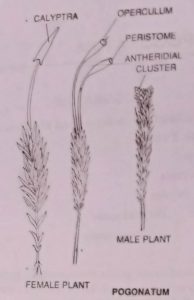
Each of the androgonial cell, appearing semicircular in a transverse section divides by a median vertical wall to form four cells. The peripheral cells, destended to form the single layered wall of the antheridium, divide only by radial and transverse walls.
The androgonial cells divide freely in a regular sequence to form numerous cells. The boundary of the original androgonial cells is clearly evident been at a later stage.
The mature club-shaped antheridia come to lie on short stalks and are intermixed with numerous uniseriate paraphysis.
The Archegonia
The archegonial initial appears as a papillate cell with dense cytoplasmic contents. It divides transversely into an upper and a lower cell. The lower cell as a result of repeated divisions in various planes develops a multicellular prominent stalk of the archegonium. The upper cell divides into three oblique divisions to form a tetrahedral cell. Three peripheral cells are cut off along three faces of the peripheral cells and divide into several planes to form the venter 2-3 cell layers thick. (BSc 1st Year Botany Pogonatum Sample Model Practice Question Answer Papers)
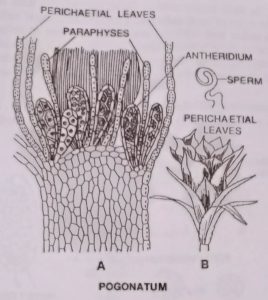
The tetrahedral cell may cut off some segments or may directly divide transversely into an outer cell with five cutting faces and a central cell below. The outer cell cuts off four sets of segments along its four active cutting faces leaving the fifth face free and gives rise to three rows of neck cells and a row of neck canal cells.
Each neck cell divides by a radial wall with the result that six rows of cells are formed. The cells of the rows divides transversely and produce a cone cell laver thick long neck of the archegonium. The neck canal cells do not divide further. The actively dividing apical cell of the archegonium corresponds to the primary cover cell.
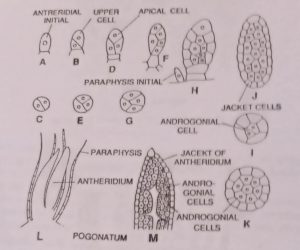
With the maturity of the archegonium the central cell divides transversely into a ventral canal cell and an egg of which both are almost identical in size
Structure of mature archegonium: The mature archegonium possesses a distended multilayered venter, two layered basal part of the neck and the single layered terminal neck. The neck canal cells are enclosed within the neck whose terminal region may have 7-8 layers of cells formed by radial division of the neck cells. The ventral canal cell and the egg are enclosed within the venter.
Fertilization
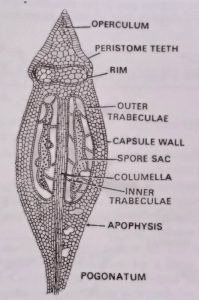
At the time of fertilization the mouth of the archegonium opens by splitting apart of the rows of neck cells. The neck canal cells and venter canal cells disintegrate to form a mucilagenous mass. The antherozoids in the film of the water present within the perichaetial leaves and swim to the egg and one fertilises it.
Development of Sporogonium
The zygote secretes a wall and divides transversely into an upper and a lower cell. The apical cell of the hypobasal cell give rise to a multicellular anchor shaped foot that become embedded in the stalk of the archegonium and subsequently in the apex of the shoot of the female plant. The cells of the foot are smaller and with dense cytoplasmic contents than those of the above living cells of the seta with poor cytoplasmic contents.
The cells formed in the epibasal half of the embryo shows regularity in their division. The further division differentiates an outer layer (amphithecium) a mass of central cells (endothecium). The amphithecium and endothecium are formed by two types of divisions:
(i) a periclinal division in a quadrant cell delimits a peripheral cell (amphithecium) from the central cell (endothecium), the peripheral cell soon divides into two by a radial wall and
(ii) a vertical division followed by another vertical wall intersecting with the previous one to form two peripheral cells (amphithecial cells) and one central cell (endothecial cell).
Both the type of above-mentioned divisions occur in the same sporogonium and even in two halves of each segment. Thus, four endothecium cells become surrounded by eight-celled amphithecium, each cell of which divides by a radial wall and forms sixteen amphithecium cells.
The epiphragm, on account of being continuous amphithecium layers, with the exception of the outer one that lies just below the operculum.
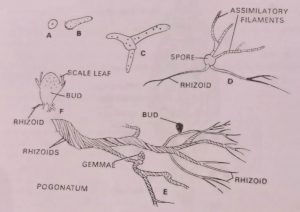
Consequent to the above development changes within the young sporogonium, enclosed within the archegonium, the multilayered venter wall gives out papillate structures from its superficial cells. These papillate structures elongate and produce dense hairy outgrowths, a characteristic feature of the calyptra. Later these hairs develop thick walls and form an effective protective covering around the young sporophyte. With the elongation of the sporogonium, the calyptra is detached from the base and lies at the tip of the capsule.
The mature sporophyte consists of a foot, a long seta, and a capsule. The capsule is cylindrical, smooth and in a cross-section appears as rounded in outline. (BSc 1st Year Botany Pogonatum Sample Model Practice Question Answer Papers)
During dry conditions, the mature sporogonium shrivels. The operculum gets detached. (BSc 1st Year Botany Pogonatum Sample Model Practice Question Answer Papers)
The epiphragm shrinks and results in the formation of narrow openings between the peristome teeth. The spores emerge through these openings and get dispersed by the swaying of the capsule in the air.
The Young Gametophyte
The spores are very small. They germinate and form gametophytes and finally form the plant body. (BSc 1st Year Botany Pogonatum Sample Model Practice Question Answer Papers)
BSc 1st Year Botany Pogonatum Sample Model Practice Question Answer Papers
BSc 1st Year Botany Pogonatum Sample Model Practice Question Answer Papers
BSc 1st Year Sample Model Practice Mock Test Question Answer Papers